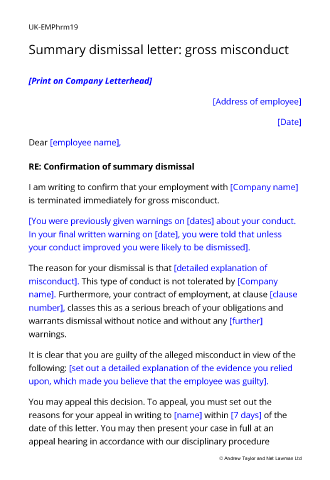Summary dismissal letter

Document overview

 England & Wales
England & Wales Scotland
Scotland

- Length:2 pages (720 words)
- Available in:
 Microsoft Word DOCX
Microsoft Word DOCX Apple Pages
Apple Pages RTF
RTF

If the document isn’t right for your circumstances for any reason, just tell us and we’ll refund you in full immediately.

We avoid legal terminology unless necessary. Plain English makes our documents easy to understand, easy to edit and more likely to be accepted.

You don’t need legal knowledge to use our documents. We explain what to edit and how in the guidance notes included at the end of the document.

Email us with questions about editing your document. Use our Lawyer Assist service if you’d like our legal team to check your document will do as you intend.

Our documents comply with the latest relevant law. Our lawyers regularly review how new law affects each document in our library.
About this document
An act of gross misconduct is considered to be serious enough to overturn the contract between employer and employee, so justifying summary dismissal.
Exactly what an organisation regards as acts of this nature should be clear from its disciplinary rules. The ACAS Code of Practice on Disciplinary and Grievance Procedures recommends that employers should tell their employees what it constitutes.
It is important note that to avoid a tribunal claim or to win a case, it is essential that the appropriate procedures are in place within your organisation and that you follow them. In particular, it is worth dealing very thoroughly and carefully with how you prepare for and give notice.
In this letter you are setting out the subject matter of your complaint. This is the time to do your homework, take statements from anyone else involved, then present the employee with your case. A well drawn letter at this stage will enable your employee's adviser to see the full position and advise your employee accordingly. A bad letter will encourage an application to a tribunal. We strongly recommend that you read further about the ACAS Code of Conduct.
Our employment letters show different styles of approach. Managerial authority is always present, but there is more sympathy in some than others, depending on the degree of blameworthiness of the employee. A gentle style may be important to preserve the goodwill of a faltering starter who is struggling to make the grade, but it is important to be very firm with for example, a blatant disregard of safety procedures.
Application and features
- Formal letter suitable for any employee or any employer, no matter the business type or size
- Written in plain English
Contents
- Details of the parties involved
- The legal position
- Employer’s legal rights
- Proposed course of action

Choose the level of support you need
Document Only
This document
Detailed guidance notes explaining how to edit each paragraph
Lawyer Assist
This document
Detailed guidance notes explaining how to edit each paragraph
Unlimited email support - ask our legal team any question related to completing the document
- Review of your edited document by our legal team including:
- reporting on whether your changes comply with the law
- answering your questions about how to word a new clause or achieve an outcome
- checking that your use of defined terms is correct and consistent
- correcting spelling mistakes
- reformatting the document ready to sign
All rights reserved
